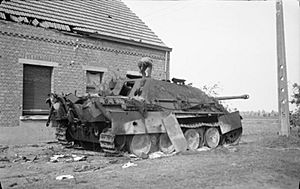Battle of Geel facts for kids
Quick facts for kids Battle of Geel |
|||||||
|---|---|---|---|---|---|---|---|
| Part of the Liberation of Belgium during World War II | |||||||
 Destroyed German Jagdpanther near Geel, 13 September 1944. |
|||||||
|
|||||||
| Belligerents | |||||||
| Units involved | |||||||
| 50th Division 15th Infantry Division Sherwood Rangers Yeomanry |
II. Fallschirmjäger Regiment Panzerjäger Abteilung 559 |
||||||
| Strength | |||||||
| unknown (at least 2 divisions) | unknown (at least 3 regiments) | ||||||
| Casualties and losses | |||||||
| 1,700—2,000 killed, wounded and captured | 2,000—2,500 killed, wounded and captured | ||||||
| 130 civilians killed | |||||||
The Battle of Geel was a major fight during World War II. It happened in Belgium near the town of Geel. British and German soldiers fought fiercely there from September 8 to September 23, 1944. This battle was one of the biggest and bloodiest during the early part of Belgium's freedom from German control.
Contents
Fighting for Geel: The Main Battle
The battle began on September 7, 1944. British troops faced German soldiers near the Albert Canal, south of Geel. The Germans were trying to get more soldiers and air force units to help them.
Crossing the Canal: British Attack
On September 8, the British 50th (Northumbrian) Division attacked. They crossed the Albert Canal. Two of their brigades, the 69th Brigade and the 151st Brigade, set up a "bridgehead." This is a safe area on the enemy's side of a river or canal.
The Germans tried many times to push them back. But by the next morning, the British had connected their bridgeheads. This allowed their armored cars to cross. Later that day, a special bridge called a Bailey bridge was built. This let Sherman tanks from the Sherwood Rangers Yeomanry cross too.
Pushing into Geel: Town Capture
On September 10, British soldiers from the 151st Brigade, helped by the Sherwood Rangers tanks, moved into Geel. They took control of the town center. The German defenders pulled back to the north of the train station.
However, the Germans fought back hard. They used elite paratroopers, called Fallschirmjägers, and powerful Jagdpanther tank-destroyers. These German forces launched continuous attacks.
German Counterattack: A Fierce Fight
The next day, the Germans attacked again. They caused heavy losses for the British in Geel. For a short time, the Germans even took back the town center. The 151st Brigade had to pull back to their starting positions at the Albert Canal.
But the Germans pushed too far. They also suffered heavy losses. Because of this, they had to leave Geel again.
Changing Divisions: New Troops Arrive
On September 12, the 50th Division, which had fought very hard, was ordered to leave Geel. They moved to another location to help with a big plan called Operation Market-Garden.
The 15th (Scottish) Division took their place. On September 13, the Germans feared being surrounded. They pulled back behind the Maas-Scheldt Canal to a village called Ten Aard. The Scottish troops then reoccupied Geel with little resistance.
Securing the Bridgehead: Ten Aard
After taking back Geel, the next goal was to cross the Maas-Scheldt Canal at Ten Aard. This would allow engineers to build a pontoon bridge (a floating bridge) for heavy equipment.
The Scottish soldiers fought for eight days to secure a bridgehead at Ten Aard. The Germans attacked them many times. The Scots managed to hold their ground, but they couldn't advance much further. The bridgehead was only about 900 meters long and 900 meters wide. Every time they tried to expand it, the Germans launched strong counterattacks.
The fighting continued until September 23. On that day, the Germans finally pulled back completely, and Ten Aard was freed.
After the Battle: What Happened Next
The overall war strategy changed after the Battle of Geel. New operations were planned to support Operation Market Garden. The Germans had to move their troops to fight other Allied attacks.
Another British division, the 53rd (Welsh) Division, crossed a canal near Lommel. They fought hard to expand their position. This new area became a starting point for other British forces to support the ground part of Operation Market Garden.
Because of these new plans and the German withdrawal, the bridgehead at Ten Aard became less important. The Scottish troops left the bridgehead to prepare for other battles further east.
The exact number of soldiers killed or wounded in the Battle of Geel is not fully known. However, at least 130 civilians were killed, mostly by artillery fire. The total number of deaths for everyone involved was likely between 1,000 and 1,100. Many more were wounded.

